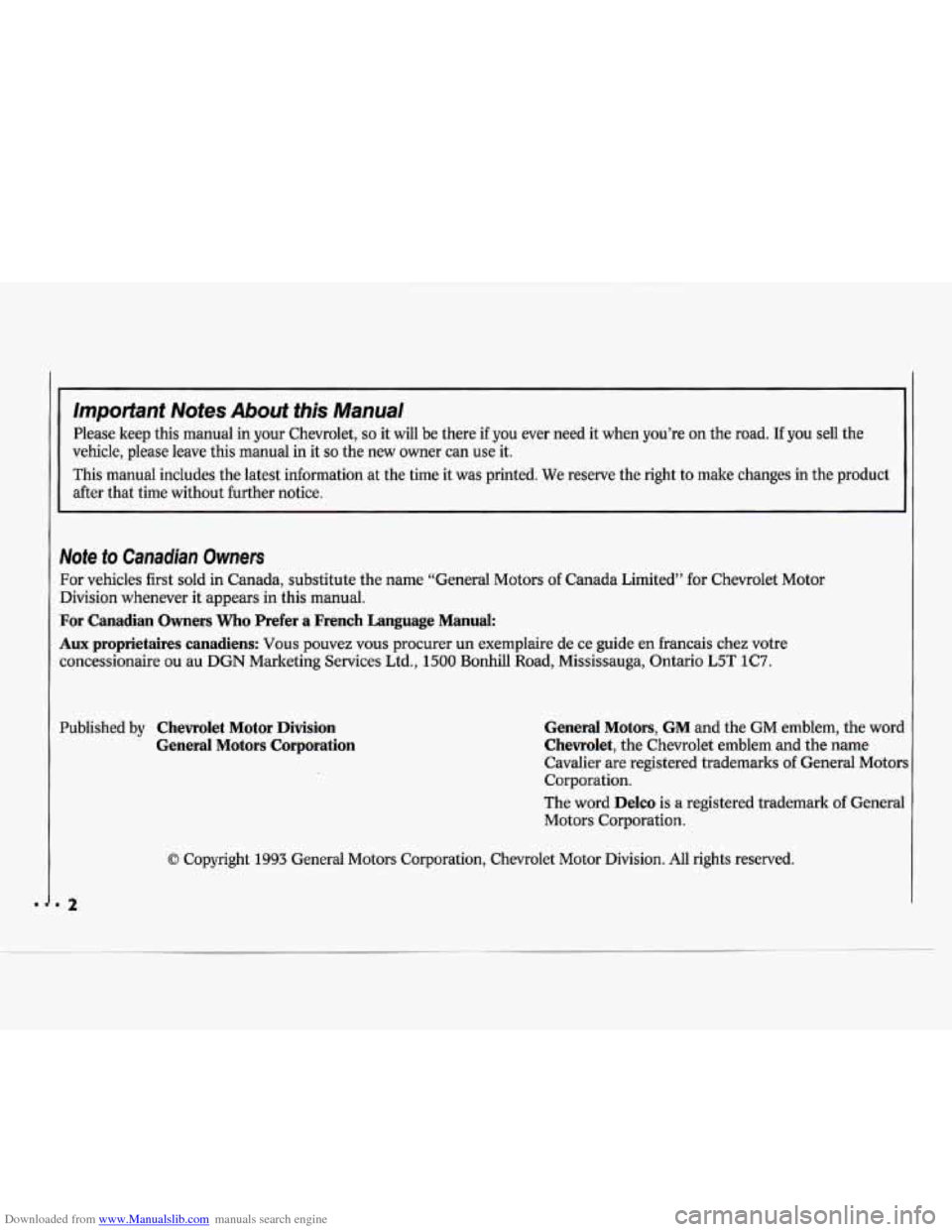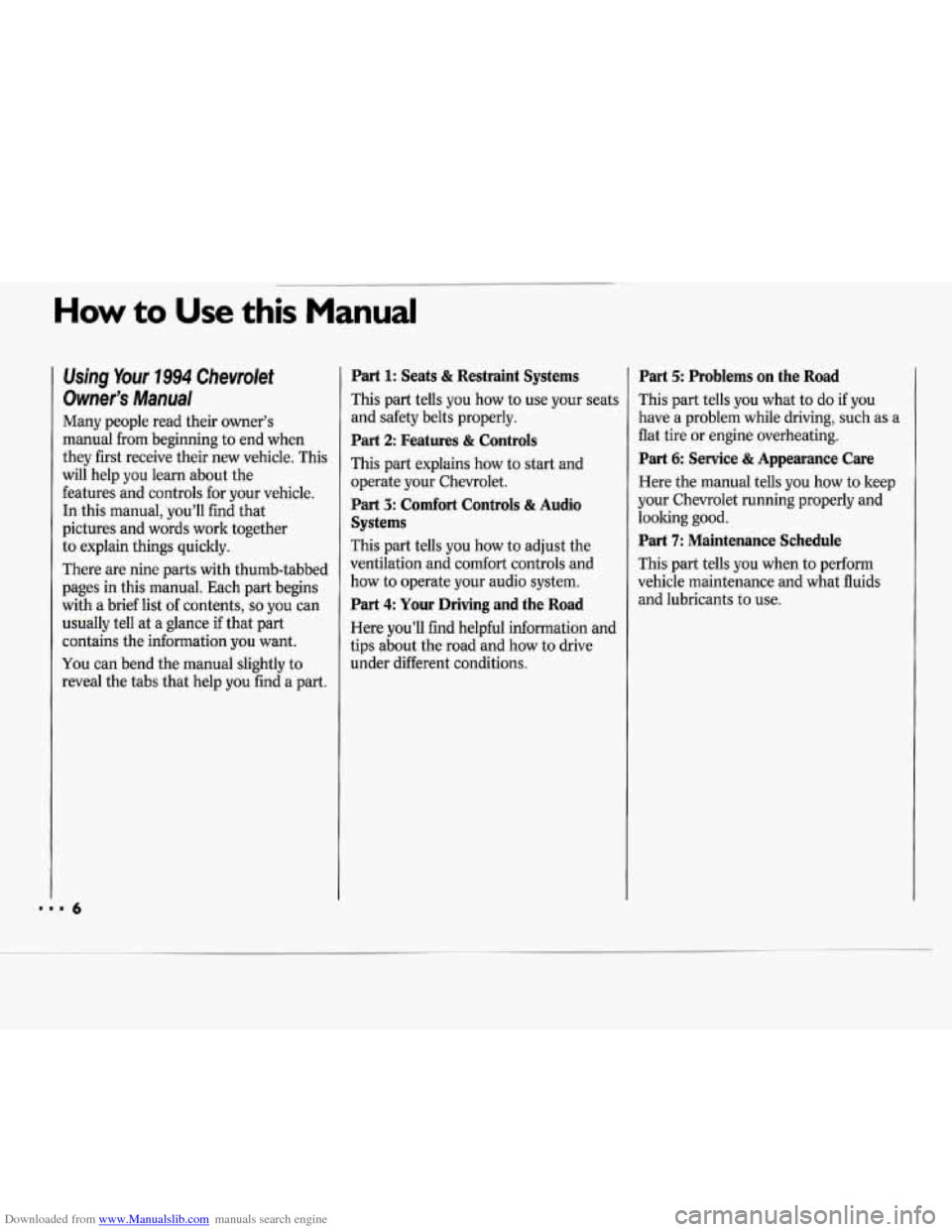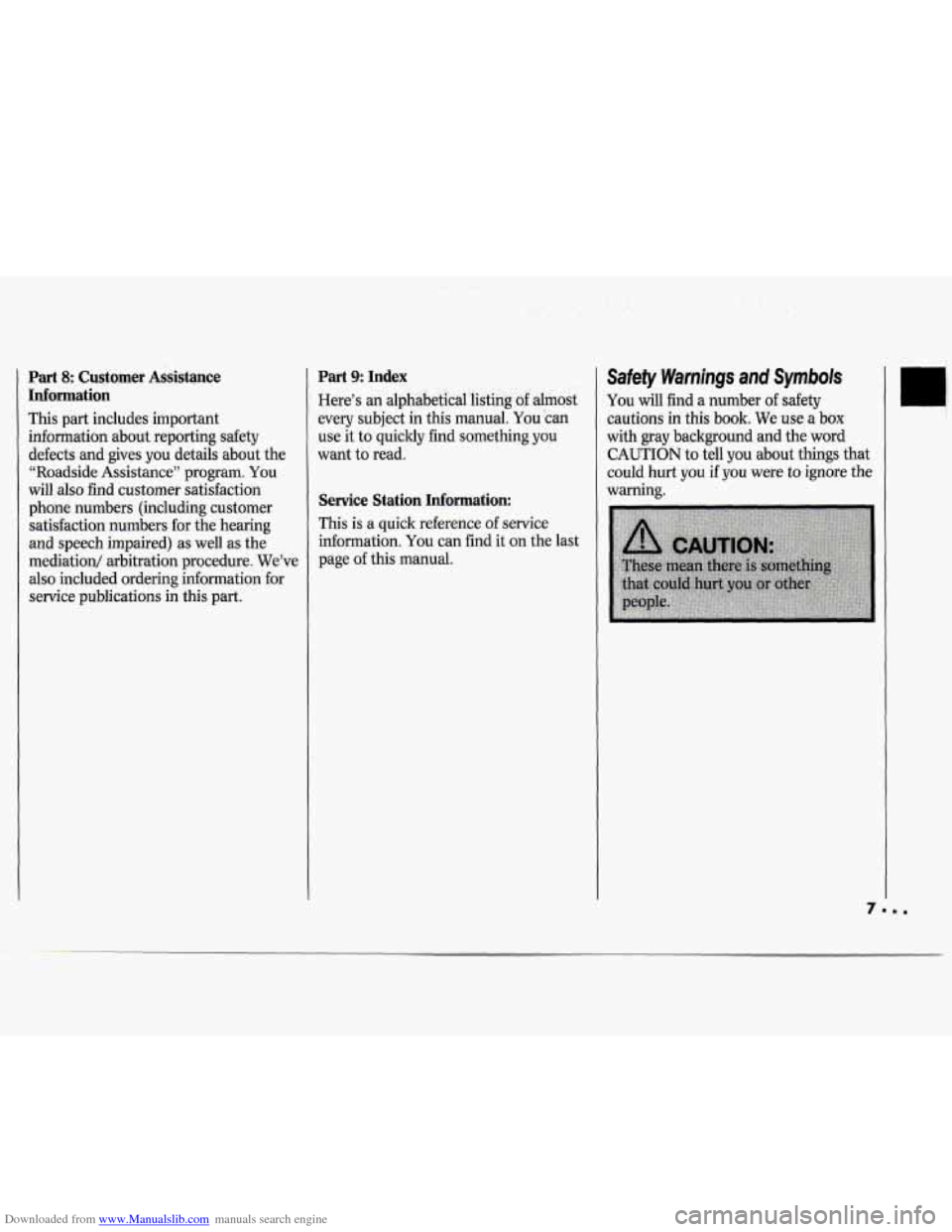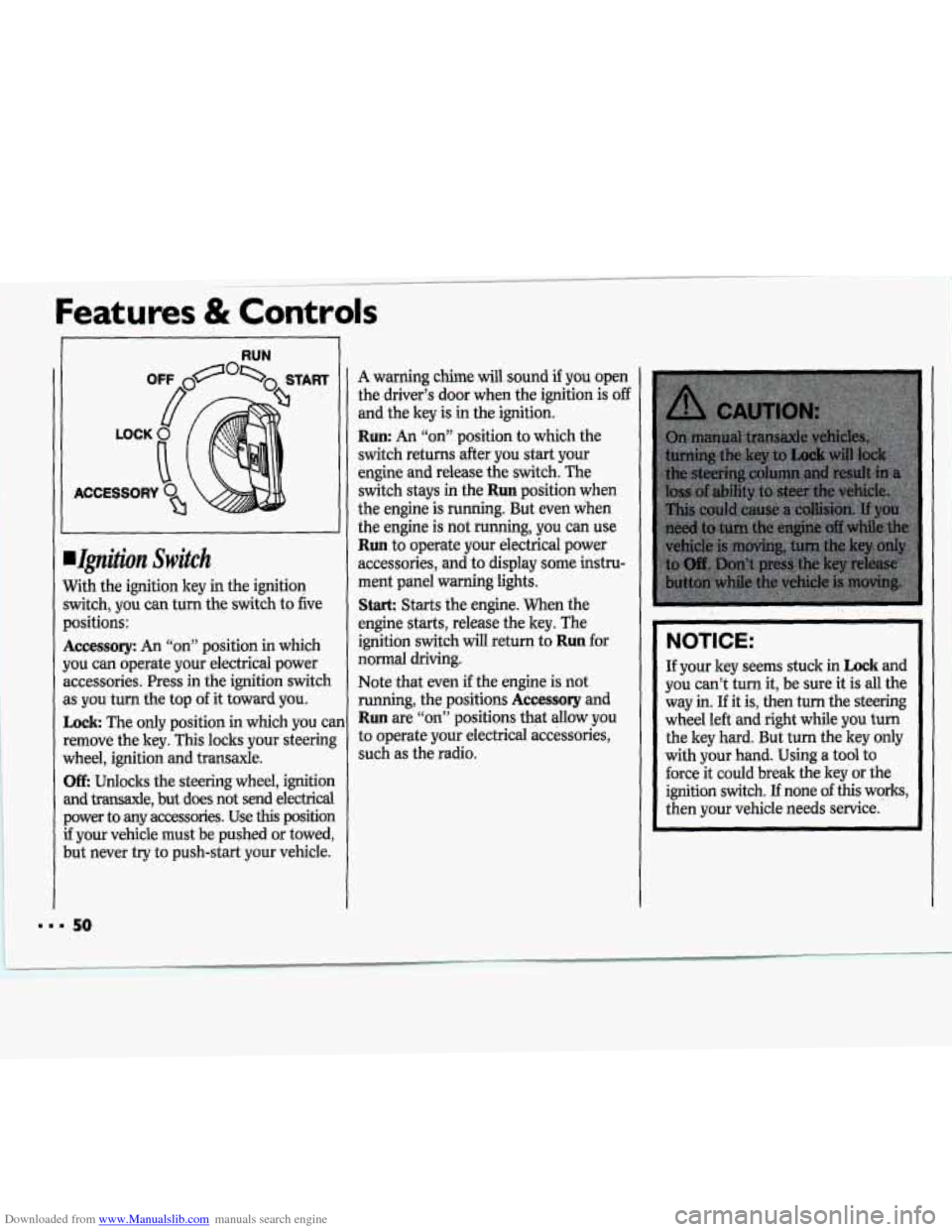1994 CHEVROLET CAVALIER service
[x] Cancel search: servicePage 2 of 243

Downloaded from www.Manualslib.com manuals search engine OChevrolet Cavalier I994 Owner’s Manual
Table of Contents
I
Part I
Part 2
Part 3
Seats & Restraint Systems.................. 1.,1
Features & Controls.. ........................... 41
Comfort Controls
& Audio Systems.... 91
Part 4 Your Driving and the Road ................ 107
Part 5 Problems on the Road ....................... 127
Part 6
Part 7
Part 8
Maintenance Schedule ...................... 203
Customer Assistance Information
.... 221
Includes “Reporting Safety Defects” on page 224
Y
Part 9
Service Station Information .... Last Page
Printed in USA 10234005 B First Edition
Page 3 of 243

Downloaded from www.Manualslib.com manuals search engine Important Notes About this Manual
Please keep this manual in your Chevrolet, so it will be there if you ever need it when you’re on the road. If you sell the
vehicle, please leave this manual in it
so the new owner can use it.
This manual includes the latest information at the time it was printed. We reserve the right to make changes in the product
after that time without further notice.
Vote to Canadian Owners
?or vehicles first sold in Canada, substitute the name “General Motors of Canada Limited” for Chevrolet Motor
Iivision whenever it appears in this manual.
?or Canadian Owners Who Prefer a French Language Manual:
lux proprietaires canadiens: Vous pouvez vous procurer un exemplaire de ce guide en francais chez votre
:oncessionaire ou au
DGN Marketing Services Ltd., 1500 Bonhill Road, Mississauga, Ontario L5T 1C7.
’ublished by
Chevrolet Motor Division
General Motors Corporation General Motors, GM and
the GM emblem, the word
Chevrolet, the Chevrolet emblem and the name
Cavalier are registered trademarks
of General Motors
Corporation.
The word
Delco is a registered trademark of General
Motors Corporation.
0 Copyright 1993 General Motors Corporation, Chevrolet Motor Division. All rights reserved.
2
Page 7 of 243

Downloaded from www.Manualslib.com manuals search engine Using Your 7994 Chevrolet
Owner’s Manual
Many people read their owner’s
manual
from beginning to end when
they first receive their new vehicle. This
will help you learn about the
features and controls for your vehicle.
In this manual, you’ll find that
pictures and words work together
to explain things quickly.
There are nine parts with thumb-tabbed
pages in this manual. Each part begins
with a brief list of contents,
so you can
usually tell at a glance if that part
contains the information you want.
You can bend the manual slightly to
reveal the tabs that help you find a part.
Part 1: Seats & Restraint Systems
This part tells you how to use your seats
and safety belts properly.
Part 2 Features & Controls
This part explains how to start and
operate your Chevrolet
.
Part 3: Comfort Controls & Audio
Systems
This part tells you how to adjust the
ventilation and comfort controls and
how to operate your audio system.
Part 4 Your Driving and the Road
Here you’ll find helpful information and
tips about the road and how
to drive
under different conditions.
Part 5: Problems on the Road
This part tells you what to do if you
have a problem while driving, such as a
flat tire or engine overheating.
Part 6: Service & Appearance Care
Here the manual tells you how to keep
your Chevrolet running properly and
looking good.
Part 7: Maintenance Schedule
This part tells you when to perform
vehicle maintenance and what fluids
and lubricants to use.
Page 8 of 243

Downloaded from www.Manualslib.com manuals search engine Part 8: Customer Assistance
Information
This part includes important
information about reporting safety
defects and gives you details about the
“Roadside Assistance” program.
You
will also find customer satisfaction
phone numbers (including customer satisfaction numbers for the hearing
and speech impaired) as well
as the
mediation/ arbitration procedure. We’ve
also included ordering information for service publications in this part.
Part 9: Index
Here’s an alphabetical listing bf almost
every subject in this manual.
You can
use it to quickly find something you
want to read.
Service Station Information:
This is a quick reference of service
information.
You can find it on the last
page of this manual.
Safety Warnings and Symbols
You will find a number of safety
cautions in this book. We use a
box
with gray background and the word
CAUTION to tell you about things that
could hurt
you if you were to ignore the
warning.
i I
I
Page 23 of 243

Downloaded from www.Manualslib.com manuals search engine I
Seats & Restraint
The lap belt should be worn as low on
:he hips as possible. In a crash, this
lpplies force to the strong pelvic bones.
2nd you’d be less likely to slide under
:he lap belt.
If you slid under it, the belt
would apply force at your abdomen.
rhis could cause serious or even fatal
njuries. The shoulder belt should go
Iver the shoulder and across the chest.
rhese parts of the body are best able to
.ake belt restraining forces.
-
Systems
The safety belt loclts if there’s a sudden
stop or
a crash.
It’s possible that an automatic belt
could keep you from fully opening a
door. That can happen if the door was
slammed shut very hard. Just close the
door all the way, then slowly open it.
If
that doesn’t fix it, then your Chevrolet
needs service.
We hope you’ll always keep your
automatic belt buckled. However, you
may need to unbuckle it in an
emergency. To unbuckle
the automatic belt, just
push the button on the buckle.
22
Page 51 of 243

Downloaded from www.Manualslib.com manuals search engine Features & Controls
RUN
.Ignition Switch
With the ignition key in the ignition
switch, you can turn
the switch to five
positions:
Accessory: An “on” position in which
you cm operate your electrical power
accessories. Press
in the ignition switch
as you turn the top
of it toward you.
Lock The only positiop in which you can
remove the key. This locks your steering
wheel, ignition and transaxle.
Off: ,Unlocks the steering wheel, ignition
and transaxle, but does not send electrical power to any accessories. Use
this position
if your vehicle must be pushed or towed,
but never try to push-start your vehicle.
A warning chime will sound if you open
the driver’s door when the ignition
is off
and the key is in the ignition.
Run: An “on” position to which the
switch returns .after you start your
engine and release’the syitch. The
switch stays
in the Run position when
the engine
is running. But even when
the engine is
not running, you can use
Run to operate your electrical power
accessories, and
to display some histru-
ment panel WarningJights.
Stark Starts the engine. When the
engine starts, release the key. The
ignition switch will return to
Run for
normal driving.
Note that even
if the engine is not
running, the positions
Accessory and
Run are “qd’ positions’that allow you
to operate your electrical accessories,
such as .the radio.
NOTICE:
I.
If your key seems stuck in Lock and
you can’t turn it, be sure
it is all the
way
in. If it is, then turn the steering
wheel le&’and right while you
iurh
the key hard. But turn the key only
with your hand. Using
a tool to
force it could break the key or the
ignition switch.
If none of this works,
then your vehicle needs service.
50
Page 86 of 243

Downloaded from www.Manualslib.com manuals search engine It takes a little more or less fuel to fill
up than the gage indicated. For
example, the gage may have indicated
the tank was half full, but it actually
took
a little more or less than half the
tank’s capacity to fill the tank.
The gage moves a little when you turn
a corner or speed up.
The gage doesn’t go back to E when
you turn off the ignition.
For your fuel tank capacity, see
Service
Station Information
on the last page of
this manual.
I80 110- -
hgine Coolant Temperature
Gage
With the ignition in the Run position,
this gage shows the engine coolant
temperature.
If the gage pointer moves into the red
area, your engine is too hot! It means
that
your engine coolant has
overheated.
If you have been operating
your vehicle under normal driving
conditions, you should pull
off the road,
stop your vehicle and turn
off the
engine as soon as possible.
HOT COOLANT CAN
BURN YOU
BADLY!
In Problems on the Road, this manual
shows what
to do. See the Index under
Engine Overheating.
Low Coolant Warning Light
(3.1 L V6 ENGINE)
If this light comes on and stays on, your
system is low on coolant and the engine
may overheat. See the
Index under
Coolant and have your vehicle serviced
as soon
as you can.
1
Page 87 of 243

Downloaded from www.Manualslib.com manuals search engine Features & Controls
II
I CHECK
L
I
I
... 86
Charging System Light
The charging system light will come on
briefly when you turn on the ignition
and the engine is not running, as a
check to show you it is working. Then it
should
go out. If it stays on, or comes
on while you are driving, you may have
a problem with the electrical charging
system. It could indicate that you have
a loose generator drive belt, or another
electrical problem. Have it checked
right away. Driving while this light is on
could drain your battery.
If you must drive a short distance with
the light on, be certain to turn
off all
your accessories, such as the radio and
air conditioner.
m
9rake Sysfem Warning Light
tour Chevrolet’s hydraulic brake
;ystem is divided into two parts. If one
)art isn’t working, the other part can
;till work and stop you. For good
)raking, though, you need both parts
vorlting well.
[f the warning light comes on, there
zould be a brake problem. Have your
brake system inspected right away.
rhis light should come
on as you start
the vehicle.
If it doesn’t come on then,
have it fixed
so it will be ready to warn
you if there’s a problem.
[f the light comes on while you are
jriving, pull off the road and stop
zarefully.
You may notice that the pedal
.s harder to push. Or, the pedal may go closer
to the floor. It may take longer to
stop.
If the light is still on, have the
vehicle towed for service. (See
Towing
Your Vehicle in the Index.)
The brake system warning light will also
come
on when you set your parking
brake, and it will stay
on if your parking
brake doesn’t release fully. If it stays on
after your parking brake is
fully
released, it means you have a brake
problem.